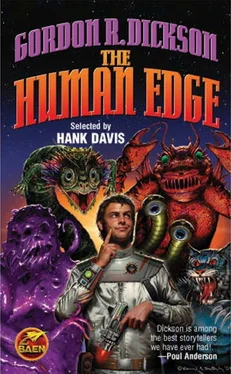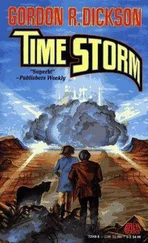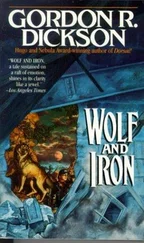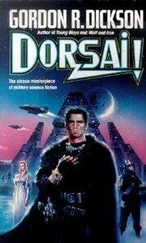Joe nodded, looking down at the form in the freeze-sack. For the aliens of the other ship there would be one similarity with the humans—a duty either to get home themselves with the news of contact, at all costs; or failing that, to see their enemy did not get home.
For a moment he found himself thinking of the frozen body before him almost as if it had been human. From what strange home world might this individual now be missed forever? And what thoughts had taken place in that round, gray-skinned skull as it had fallen surfaceward clinging to the ship of its enemies, seeing the certainty of its own death approaching as surely as the rocky mountainside?
“Do we have record films of the battle?” Joe asked.
“I’ll get them.” Maury went off.
He brought the films. Joe, feeling the weakness of his condition stealing up on him, pushed it aside and set to examining the pictorial record of the battle. Seen in the film viewer, the battle had a remote quality. The alien ship was smaller than Joe had thought, half the size of the Harrier. The two dropped weights had made large holes in its midships. It was not surprising that it had broken apart when rammed.
One of the halves of the broken ship had gone up and melted in a sudden flare of green light like their weapons beam, as if some internal explosion had taken place. The other half had fallen parallel to the Harrier and almost as slowly—as if the fragment, like the dying Harrier, had had yet some powers of flight—and had been lost to sight at last on the opposite side of this mountain, still falling.
Four gray bodies had spilled from the alien ship as it broke apart. Three, at least, had fallen some five miles to their deaths. The record camera had followed their dwindling bodies. And Maury was right; these had been changing even as they fell, flattening and spreading out as if in an instinctive effort to slow their fall. But, slowed or not, a five-mile fall even in this lesser-than-Earth gravity was death.
Joe put the films aside and began to ask Maury questions.
The Harrier, Maury told him, would never lift again. Half her drive section was melted down to magnesium alloy slag. She lay here with food supplies adequate for the men who were left for four months. Water was no problem as long as everyone existed still within the ship’s recycling system. Oxygen was available in the local atmosphere and respirators would extract it. Storage units gave them housekeeping power for ten years. There was no shortage of medical supplies, the tool shop could fashion ordinary implements, and there was a good stock of usual equipment.
But there was no way of getting off this mountain.
The others had come into the bubble while Maury had been speaking. They stood now around the bed. With the single exception of Cal, who showed nothing, they all had a new, taut, skinned-down look about their faces, like men who have been recently exhausted or driven beyond their abilities.
“Look around you,” said Jeff Ramsey, taking over from Maury when Maury spoke of the mountain. “Without help we can’t leave here.”
“Tell him,” said Doug Kellas. Like young Jeff, Doug had not shaved recently. But where Jeff’s stubble of beard was blond, Doug’s was brown-dark and now marked out the hollows under his youthful cheekbones. The two had been the youngest of the Team.
“Well, this is a hanging valley,” said Jeff. Jeff was the surface man geologist and meteorologist of the Team. “At one time a glacier used to come down this valley we’re lying in, and over that edge there. Then the valley subsided, or the mountain rose or the climate changed. All the slopes below that cliff edge—any way down from here—brings you finally to a sheer cliff.”
“How could the land raise that much?” murmured Maury, looking out and down at the green too far below to tell what it represented. Jeff shrugged.
“This is a bigger world than Earth—even if it’s lighter,” he said. “Possibly more liable to crustal distortion.” He nodded at the peaks above them. “These are young mountains. Their height alone reflects the lesser gravity. That glacier up there couldn’t have formed on that steep a slope on Earth.”
“There’s the Messenger,” said Cal.
His deeper-toned voice brought them all around. He had been standing behind the rest, looking over their heads. He smiled a little dryly and sadly at the faint unanimous look of hostility on the faces of all but the Survey Leader’s. He was unusual in the respect that he was so built as not to need their friendship. But he was a member of the Team as they were and he would have liked to have had that friendship—if it could have been had at any price short of changing his own naturally individualistic character.
“There’s no hope of that,” said Doug Kellas. “The Messenger was designed for launching from the ship in space. Even in spite of the lower gravity here, it’d never break loose of the planet.”
The Messenger was an emergency device every ship carried. It was essentially a miniature ship in itself, with drive unit and controls for one shift through no-time and an attached propulsive unit to kick it well clear of any gravitic field that might inhibit the shift into no-time. It could be set with the location of a ship wishing to send a message back to Earth, and with the location of Earth at the moment of arrival—both figured in terms of angle and distance from the theoretical centerpoint of the galaxy, as determined by ship’s observations. It would set off, translate itself through no-time in one jump back to a reception area just outside Earth’s critical gravitic field, and there be picked up with the message it contained.
For the Harrier team, this message could tell of the aliens and call for rescue. All that was needed was the precise information concerning the Harrier’s location in relation to Galactic Centerpoint and Earth’s location.
* * *
In the present instance, this was no problem. The ship’s computer log developed the known position and movement of Earth with regard to Centerpoint, with every shift and movement of the ship. And the position of the second planet of star K94 was known to the chartmakers of Earth recorded by last observation aboard the Harrier.
Travel in no-time made no difficulty of distance. In no-time all points coincided, and the ship was theoretically touching them all. Distance was not important, but location was. And a precise location was impossible—the very time taken to calculate it would be enough to render it impossibly inaccurate. What ships travelling by no-time operated on were calculations approximately as correct as possible—and leave a safety factor, read the rulebook.
Calculate not to the destination, but to a point safely short enough of it, so that the predictable error will not bring the ship out in the center of some solid body. Calculate safely short of the distance remaining… and so on by smaller and smaller jumps to a safe conclusion.
But that was with men aboard. With a mechanical unit like the Messenger, a one-jump risk could be taken.
The Harrier had the figures to risk it—but a no-time drive could not operate within the critical area of a gravitic field like this planet’s. And, as Jeff had said, the propulsive unit of the Messenger was not powerful enough to take off from this mountainside and fight its way to escape from the planet
“That was one of the first things I figured,” said Jeff, now. “We’re more than four miles above this world’s sea-level, but it isn’t enough. There’s too much atmosphere still above us.”
“The Messenger’s only two and a half feet long put together,” said Maury. “It only weighs fifteen pounds earthside. Can’t we send it up on a balloon or something? Did you think of that?”
Читать дальше












